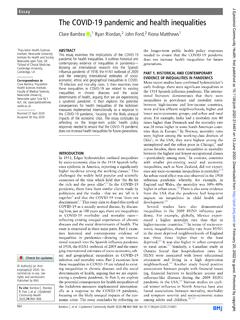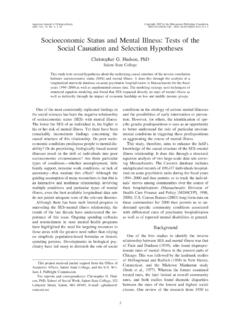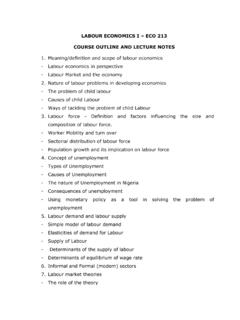Transcription of Tackling the wider social determinants of health and ...
1 Tackling the wider social determinants of health andhealth inequalities: evidence from systematic reviewsC Bambra,1M Gibson,2A Sowden,3K Wright,3M Whitehead,4M Petticrew5 ABSTRACTB ackgroundThere is increasing pressure to tackle thewider social determinants of health through theimplementation of appropriate interventions. However,turning these demands for better evidence aboutinterventions around the social determinants of healthinto action requires identifying what we already knowand highlighting areas for further review methodology was used toidentify systematic reviews (from 2000 to 2007,developed countries only) that described the healtheffects of any intervention based on the wider socialdeterminants of health .
2 Water and sanitation, agricultureand food, access to health and social care services, unemployment and welfare, working conditions, housingand living environment, education, and systematic reviews were , the effects of interventions on healthinequalities were unclear. However, there is suggestivesystematic review evidence that certain categories ofintervention may impact positively on inequalities or onthe health of specific disadvantaged groups, particularlyinterventions in the fields of housing and the studies that addressinequalities in health are a priority area for future publichealth is well established that health follows a socialgradient.
3 Better health with increasing socioeco-nomic importance of the social (asopposed to biological or genetic) causes of thisgradientdfor example, housing quality, access tohealthcare or quality of work, has also been turn, this has lead to increasing pres-sure in research, practice and policy-makingenvironments to tackle these wider social determi-nants of health , through the implementation ofappropriate interventions, and thereby reducing thegradient and health , there are two concurrent , the social determinants evidence base isdominated by descriptive, epidemiological studiesthat, by highlighting associations, are onlyimplicitly able to suggest possible example.
4 Studies consistently show associa-tions between higher job control and better mentalhealth; by implication, therefore, interventionsthat increase job control should result in is lacking though is furtherevidence about what sort of interventions mightbe required or whether they will actually beeffective in improving health or reducing the , where interventions aimed at reducinghealthinequalities have been developed and evalu-ated, they tend to focus on modifying lifestylefactors such as smoking. This may reflect the factthat lifestyle issues are often easier to identify andtreat, or it may be indicative of differences in therespective evidence bases; with evidence on tacklingthe wider social determinants being less apparentand less accessible to policy makers and practi-tioners.
5 Therefore, what is needed is evidence aboutwhat can actually be done to tackle the socialdeterminants of health and health inequal-itiesdspecifically which interventions are effectiveand for requires evaluative studies ofinterventions that address the social determinantsof WHO Measurement and EvidenceKnowledge Networkdfor example, noted that it isvital to continue to develop evidence bases abouttackling the social determinants of health andhealth , turning this need for better evidenceabout interventions around the social determinantsof health into action requires the identification ofwhat we already know in terms of the effects ofinterventions and also identifying areas where newstudies are needed.
6 This information could then beused to identify priorities for new research. It wasin this context that the English Department ofHealth, Policy Research Programme, via the PublicHealth Research Consortium, commissioned thisumbrella review. Umbrella reviews are an increas-ingly common way of identifying, appraising andsynthesising systematic review , umbrella reviews are able to present theoverarchingfindings of such systematic article therefore synthesises recent systematicreviews on the effects on health and healthinequalities of interventions aimed at influencingthe social determinants of review methodology was used to locateand evaluate published and unpublished systematicreviews of interventions around the wider socialdeterminants of health ( umbrella review).
7 Search strategyInitially, the Centre for Reviews and DisseminationWider Public health database (a web-based data-base of systematic reviews of public health andrelated interventions) was manually searched. Thisconsists of evidence from systematic reviews rele-vant to public health policy and practice and coversthe period from 2000 to 2002. To supplement this,the Cochrane Database of Systematic Reviews and<A supplementary appendix ispublished online only at of Geography,Durham University, Durham, UK2 MRC social and Public HealthSciences Unit, Glasgow, UK3 Centre for Reviews andDissemination, University ofYork, York, UK4 Division of Public health ,University of Liverpool,Liverpool, UK5 Public and Environment HealthResearch Unit, London School ofHygiene and Tropical Medicine,London, UKCorrespondence toClare Bambra, Department ofGeography, Wolfson ResearchInstitute, Durham UniversityQueen s Campus.
8 Stockton onTees TS17 6BH, 3 June 2009 This paper is freely availableonline under the BMJ Journalsunlocked scheme, see Epidemiol Community Health2010;64:284e291. on August 12, 2022 by guest. Protected by Epidemiol Community health : first published as on 19 August 2009. Downloaded from the Database of Abstracts of Reviews of Effects (both adminis-trative and public databases) were searched electronically,whereas the Campbell Collaboration Database and the EPPIC entre database of health promotion and public health studieswere manually searched from January 2002 to April searches of the Criminal Justice Abstracts database(2000e2007) were also undertaken (as it is not covered by any ofthese databases of systematic reviews).
9 Bibliographies, referencelists and relevant websites were also searched. Experts werecontacted and we hand searched four leading journals (AmericanJournal of Public health ,American Journal of Preventive Medicine,Journal of Epidemiology and Community health , social Science andMedicine) from January 2002 to April 2007. Full search strategy isin web appendix and exclusion criteriaWe used the widely cited Dahlgren and Whitehead rainbowmodel of the main determinants of health (figure 1) as a frame-work to help to identify the range of social determinants uponwhich interventions could be concentrated on theouter two layers, which included macroeconomic, cultural andenvironmental conditions in the outermost layer.
10 And living andworking conditions and access to essential goods and services inthe next layer, specifically water and sanitation, agriculture andfood, access to health (and social care) services, unemployment (and welfare), work conditions, housing (and living environ-ment), education and transport. We therefore excluded reviewsthat only examined interventions based on the inner most layersof the rainbow: individual lifestyle factors and social andcommunity studies of adult participants (16+) or the generalpopulationin developed countries (North America, Europe,Australasia, Japan) were eligible for inclusion.










